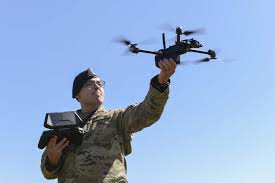Unmanned Aerial Vehicles (UAVs), generally known as drones, have become pivotal assets in military operations around the globe. Their ability to operate without a human pilot onboard allows various applications, from reconnaissance to direct engagement. This technology enhances both the precision and safety of military missions, significantly transforming modern warfare.
Precision in Targeting and Surveillance
Precision in targeting and surveillance is a hallmark of modern drone technology, which significantly enhances military operations. Military Drones, equipped with state-of-the-art high-resolution cameras and a suite of sensory equipment, can perform detailed reconnaissance over wide areas or focus on specific locations. This ability to gather high-quality visual and thermal data is crucial for building a comprehensive understanding of the battlefield dynamics without putting human operators at risk.
The sophisticated sensors onboard drones can detect changes in the environment, track moving targets, and identify potential threats from a distance. These capabilities are useful in direct combat situations and intelligence-gathering missions, where identifying enemy positions and their movements is critical for planning offensive or defensive actions. The data collected by drones is often real-time or near-real-time, providing commanders with timely information essential for making swift, strategic decisions.
Minimizing Collateral Damage
The ability of drones to loiter over targets for extended periods allows for more precise actions and significantly reduces unintended consequences. This persistent surveillance is crucial in conflict zones where the difference between combatants and civilians can be blurred, ensuring that every strike is executed only after exhaustive target verification.
The real-time data provided by drones is invaluable in dynamic battlefield conditions. Command centers receive up-to-the-minute information, allowing commanders to make informed decisions that consider both the tactical objectives and the need to protect civilian lives. This capability is particularly important during urban operations, where the risk to non-combatants is heightened. The strategic use of drones thus supports a more disciplined and calculated approach to engagement, emphasizing the importance of precision in modern warfare and the ethical responsibility to avoid harm to civilians whenever possible.
Efficient Operational Safety
Drones contribute significantly to the safety of military personnel. Traditional reconnaissance missions often put soldiers at risk, but drones can effectively take over these roles. By deploying UAVs into dangerous zones, the need for manned missions in such areas is reduced, minimizing the risk to human lives.
Extending Mission Capabilities
Drones are not limited by the physical and psychological constraints that humans face. They can operate in environments considered too risky or inaccessible for manned aircraft. This includes missions at extreme altitudes, over contaminated areas, or in close proximity to hazardous threats. As a result, drones extend the capabilities of military forces, allowing them to execute operations that were previously impossible or required significant human sacrifice.
Cost-Effectiveness and Resource Allocation
Another significant benefit of using drones in military operations is their cost-effectiveness compared to traditional manned aircraft. The operational costs of drones are considerably lower, as they require less fuel and maintenance. Additionally, the risk of losing human lives is drastically reduced, saving lives and the expenses related to training and equipping military personnel.
Optimizing Resource Utilization
Drones allow military forces to allocate their resources more effectively. By taking on surveillance and minor engagement roles, drones free up manned aircraft for more critical missions that require human judgment and experience. This strategic division of labor helps optimize the overall military effort, ensuring that each mission is carried out by the most suitable means.
Ensuring Accountability
Ensuring accountability in the use of drones is paramount as their role in military operations expands. The automation provided by drones requires robust oversight mechanisms to monitor and regulate their use effectively. Establishing stringent controls and transparent policies helps to maintain ethical standards and compliance with international law. This accountability framework is essential to ensure that all drone operations are justified and documented, reducing the risks of misuse and maintaining public and international trust in military practices.
Future Prospects of Drone Technology
The future of drone technology in military operations looks promising, with ongoing advancements in artificial intelligence (AI) and machine learning enhancing the capabilities of these systems. Future drones are expected to be more autonomous and capable of performing more complex decision-making tasks without human intervention.
Integrating Emerging Technologies
As drone technology continues to evolve, the integration of newer systems like facial recognition software, automated threat detection algorithms, and enhanced communication systems will further augment the effectiveness of military operations. These technologies will make drones smarter and more responsive to dynamic battlefield conditions.
Military Drones have undeniably transformed covert operations by enhancing precision and ensuring the safety of troops. With their ability to perform various tasks, from surveillance to direct engagement, drones provide a significant strategic advantage. However, it is imperative to continue addressing the ethical essences and challenges associated with their use.

